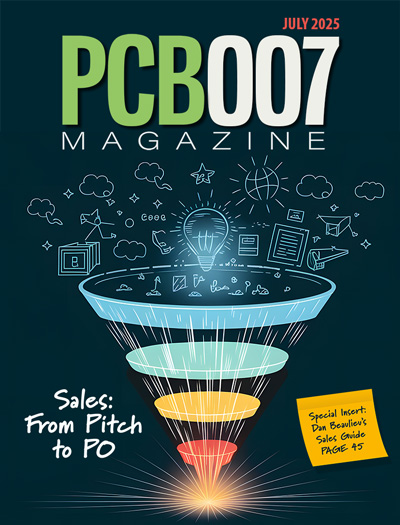-

- News
- Books
Featured Books
- pcb007 Magazine
Latest Issues
Current Issue
Advancing the Advanced Materials Discussion
Moore’s Law is no more, and the advanced material solutions to grapple with this reality are surprising, stunning, and perhaps a bit daunting. Buckle up for a dive into advanced materials and a glimpse into the next chapters of electronics manufacturing.

Inventing the Future With SEL
Two years after launching its state-of-the-art PCB facility, SEL shares lessons in vision, execution, and innovation, plus insights from industry icons and technology leaders shaping the future of PCB fabrication.

Sales: From Pitch to PO
From the first cold call to finally receiving that first purchase order, the July PCB007 Magazine breaks down some critical parts of the sales stack. To up your sales game, read on!
- Articles
- Columns
- Links
- Media kit
||| MENU - pcb007 Magazine
Indian PCB Market Projected to Reach $20.17 Billion by 2032
October 5, 2024 | openPREstimated reading time: 1 minute
The Indian printed circuit board (PCB) market has witnessed significant growth in recent years, reaching a value of US$4.53 billion in 2023. As the electronics manufacturing sector in India continues to expand, the demand for PCBs is rising steadily. Printed circuit boards are the backbone of almost all electronic devices, making them an essential component in industries such as telecommunications, automotive, consumer electronics, and more. The market is expected to grow at an impressive compound annual growth rate (CAGR) of 18.1% between 2024 and 2032, eventually reaching a projected value of nearly $20.17 billion by 2032.
India Printed Circuit Board (PCB) Market Size
As of 2023, the Indian PCB market reached a value of $4.53 billion, supported by the rising demand for electronic products across various industries. The country's electronics manufacturing sector has seen substantial growth, and PCBs are a vital part of this expansion. With the Indian government's push to promote local manufacturing and reduce import dependency, the demand for domestic PCB production is expected to rise further.
Looking ahead, the market is forecast to grow at a CAGR of 18.1% between 2024 and 2032. By 2032, the Indian PCB market is projected to reach nearly USD 20.17 billion, driven by the increasing adoption of advanced technologies and the need for more sophisticated electronic devices.
India Printed Circuit Board (PCB) Market Trends
Government Initiatives and Policy Support: Initiatives like "Make in India" and the Production Linked Incentive (PLI) scheme for the electronics sector are encouraging domestic manufacturing of PCBs. These programs provide incentives for companies to invest in local production, reducing reliance on imports.
Growth of the Automotive Electronics Market: With the rise of electric vehicles (EVs) and the increasing incorporation of electronic systems in automobiles, the demand for PCBs in the automotive sector is growing rapidly.
5G Rollout and Telecommunications Growth: The upcoming 5G technology rollout is expected to drive the demand for PCBs, as telecommunications infrastructure requires high-performance circuit boards.
Consumer Electronics Boom: With the rapid adoption of smartphones, tablets, and wearable devices, the demand for PCBs in the consumer electronics sector is soaring. This trend is expected to continue as India becomes one of the largest markets for consumer electronics.
Focus on Sustainability: As environmental concerns grow, there is a rising demand for eco-friendly and energy-efficient PCBs. Companies are focusing on developing PCBs with reduced environmental impact by utilizing sustainable materials and production processes.
Testimonial
"Our marketing partnership with I-Connect007 is already delivering. Just a day after our press release went live, we received a direct inquiry about our updated products!"
Rachael Temple - AlltematedSuggested Items
Fresh PCB Concepts: Investing in Tomorrow's PCB Experts Today
09/24/2025 | Team NCAB -- Column: Fresh PCB ConceptsPeople often describe the PCB industry as one of the most critical yet invisible foundations of modern electronics. Every project needs a PCB, but few college programs or engineering curricula cover the complexity of board design, stackups, or manufacturability. That means the responsibility for developing the next generation of PCB experts falls on the industry itself.
American Made Advocacy: Congress Back from Break With Work To Do
09/23/2025 | Shane Whiteside -- Column: American Made AdvocacyAs Washington wakes up after the August Congressional recess, leaders from both sides of the aisle confront a host of serious policy challenges. One of the challenges is reauthorizing the Defense Production Act (DPA), a U.S. law that gives the president broad authority to influence the domestic industrial base to support national defense and emergency preparedness.
Electrodeposited Copper Foils Market to Grow by $11.7 Billion Over 2025-2032
09/18/2025 | Globe NewswireThe global electrodeposited copper foils market is poised for dynamic growth, driven by the rising adoption in advanced electronics and renewable energy storage solutions.
HDI PCB Market Poised for Explosive Growth, Projected to Hit $34.23 Billion by 2032
09/04/2025 | Globe NewswireAccording to Coherent Market Insights (CMI), the global HDI PCB market size is projected to expand at a CAGR of 8.3% over the forecast period, reaching USD 19.59 Bn in 2025 and USD 34.23 Bn by 2032.
American Made Advocacy: Where’s the Budget for a Modern Military Run on Microelectronics?
08/19/2025 | Shane Whiteside -- Column: American Made AdvocacyIn a world of peer threats and urgent transformation, having secure, trusted, and reliable microelectronics is non-negotiable. While largely hidden, microelectronics are the ubiquitous enablers of modern defense platforms. Nothing in the current American arsenal flies, floats, or fights without a technology stack that includes a semiconductor, an integrated circuit substrate, and a printed circuit board.


